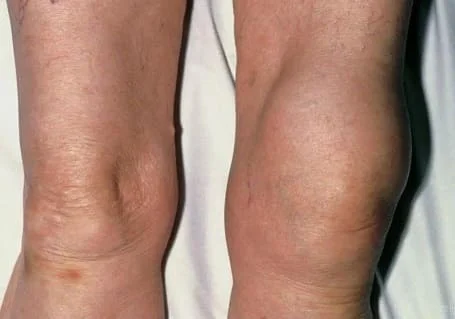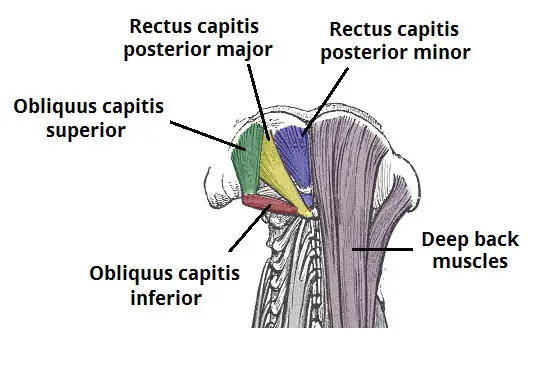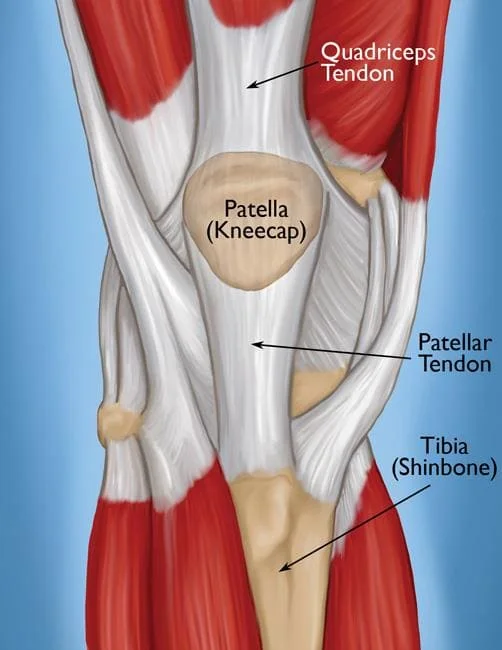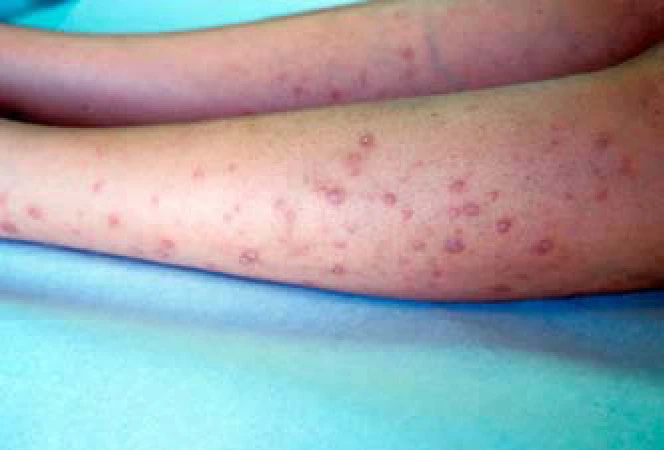Swollen Knee
What is a Swollen Knee?
When extra fluid builds up in or around your knee joint, it can cause a swollen knee. This condition may be referred to by medical professionals as a knee joint effusion (uh-FU-zhun).
Trauma, overuse injuries, or an underlying illness or condition can all cause a swollen knee. Your healthcare professional may need to test a sample of the fluid for an infection, disease, or blood from an injury in order to determine the reason for the swelling.
Partially draining the fluid might assist in easing the discomfort and stiffness brought on by the swelling. Treatment can start when the underlying reason has been diagnosed.
Onset of swelling
Any swelling that develops right after an accident is indicative of a substantial haemarthrosis, or bleeding brought on by harm to a ligament or bone. Traditionally, swelling that develops 24–36 hours after injury might be attributed to a sympathetic effusion or a slowly developing haemarthrosis, which could be brought on by a meniscal injury, for example.
Associated Symptoms
Typical symptoms and signs include:
- Knee Swelling: When you compare the affected knee to your other knee, you may noticeably see an increase in skin edema around your kneecap.
- Knee Stiffness: You may find that you are limited in how far you can bend or straighten your leg when there is extra fluid in your knee joint.
- Knee Pain: Your knee may be so painful that you are unable to bear weight on it, depending on what caused the fluid buildup.
Causes of Knee Swelling
A swollen knee can be caused by a variety of issues, from illnesses and other ailments to traumatic traumas.
Injury
Any type of damage to the knee might result in an accumulation of extra joint fluid. The following injuries have the potential to accumulate fluid in and around the knee joint:
- Damaged ligament, especially the ACL (anterior cruciate ligament)
- Cartilage (meniscus) tear
- Irritation from overuse
- Broken bones
- Hyperextended knees.
- Dislocations.
- Patellofemoral pain syndrome (PFPS).
ACL injury
One of the important ligaments that aids in stabilizing the knee joint is the anterior cruciate ligament (ACL). joins the shinbone (tibia) to the thighbone (femur). It usually tears when playing sports like basketball, soccer, tennis, and volleyball which require quick stops and direction changes.
Torn meniscus
Between the shinbone and the thighbone, the meniscus is a C-shaped section of durable, rubbery cartilage that serves as a stress absorber. Your knee may rupture if you twist it rapidly while bearing weight on it.
Knee Bursitis
Knee Bursitis is the outcome of inflammation of the knee’s fluid-filled bursae.
An inflammatory response in the knee causes swelling. The pressure of the swelling on other knee components may cause pain.
The American Academy of Orthopaedic Surgeons says that the most common causes of bursitis are frequent kneeling or blunt force injuries to the knee.
To determine this, a physician checks the knee and may recommend imaging tests like an MRI or X-ray. A combination of the following therapies may be applied if bursitis is the underlying cause:
- Compression
- Using ice packs
- Elevating the knee
- Resting
- Pain Relieving Medicine Mainly nonsteroidal anti-inflammatory drugs (NSAIDs)
Knee Arthritis
Another common reason for knee swelling is arthritis. The five crucial markers of acute inflammation might be present in an individual with arthritis even if they have underlying chronic inflammation.
The Arthritis Foundation states that knee swelling can result from a number of different forms of arthritis, including:
The most common type of arthritis is osteoarthritis, which is caused by the degeneration of knee cartilage; rheumatoid arthritis is an inflammatory type of arthritis where the immune system assaults the joints inadvertently.
Juvenile arthritis affects those who are 16 years of age or younger. Reactive arthritis is a chronic kind that frequently develops after a genital infection. Urinary tract infectious arthritis is a form of arthritis that develops when an infection results in joint swelling.
One kind of arthritis called gout is caused by an excess of uric acid in the blood.
A doctor will inquire about further symptoms and review the patient’s medical history if they suspect arthritis. They might also request imaging tests like an X-ray and blood work.
The optimal course of treatment varies depending on the kind of arthritis but may consist of:
- Pain relief medication, mainly NSAIDs
- Lifestyle changes, such as exercise
- Physical therapy
- Corticosteroids
- Disease-modifying antirheumatic drugs
- Assistive devices
- Surgery
Underlying Conditions and Diseases
The following underlying medical conditions have the potential to cause fluid accumulation in and around the knee joint:
- Osteoarthritis
- Rheumatoid arthritis
- Infection
- Gout
- Pseudogout
- Cysts
- Tumors
Risk factors
The following variables could make you more susceptible to knee swelling:
Age: As you become older, you have a higher chance of having an arthritis-related swelling knee.
Athletics. Individuals who play sports that require knee twisting, like basketball, are more susceptible to knee injuries that result in edema.
Being overweight. A swollen knee can result from tissue and joint overload, knee deterioration, and increased tension on the knee joint caused by excess weight.
Complications of Swollen Knee
Some consequences of a swollen knee are as follows:
- Muscle Weakness. Fluid in the knee can impair muscle activity and lead to atrophy and weakening of the thigh muscles.
- A fluid-filled sac (Baker cyst). A Baker cyst in the back of your knee may develop as a result of fluid accumulation in your knee. Although a bloated Baker cyst might cause pain, compression and cooling usually help. You may require a needle procedure to remove fluid if the edema is very bad.
How to Prevent Swollen Knee?
The most common cause of a swollen knee is an accident or long-term medical condition. To maintain general health and avoid getting hurt:
- Strengthen the muscles surrounding your knee. Strong surrounding muscles of a joint can alleviate stress on the joint itself.
- Select low-impact physical activities. Some exercises, like swimming and water aerobics, don’t require your knee joints to bear weight all the time.
- Sustain a healthy weight. A swollen knee can result from wear and tear damage, which is exacerbated by excess weight.
Diagnosis
Your doctor will probably begin by taking a thorough medical history and performing a physical examination. After that, tests to determine the cause of your swelling knee are probably necessary.
Imaging examinations
Imaging tests can assist in locating the issue. Choices consist of:
- X-ray. An X-ray can diagnose arthritis and rule out fractured or dislocated bones.
- Ultrasound. This exam looks for conditions affecting the tendons or ligaments using sound waves.
- MRI MRI uses a powerful magnetic field and radio waves to identify soft tissue lesions, such as ligaments and tendons, that are not evident on X-rays.
Aspiration done jointly (arthrocentesis)
Your knee’s internal fluid is removed using a needle. After that, the following is looked for in this fluid:
- Blood can result from bleeding illnesses or traumas.
- bacteria that could be the source of an illness
- crystals typical of pseudogout or gout
Treatment of Knee Swelling
The reason, severity, and medical history of your swollen knee all influence the course of treatment.
Physical Therapy Treatment
You can strengthen and function better in your knees with physical therapy exercises. Under certain circumstances, a knee brace could be useful.
Do knee exercises
You can strengthen the muscles that support your knee by performing isometric workouts after the injury has partially healed. Strong surrounding muscles can aid in releasing pressure from the joint. Moreover, these activities can aid in the decrease of knee fluid.
Maintaining strong knees is usually a good idea as a prophylactic against knee edema and injury. Maintaining strong knees can benefit from the following exercises:
Weight training and flexibility training
low-impact workouts like swimming and water aerobics
Sustaining a healthy weight can also aid in avoiding needless wear and tear that may cause a knee enlargement.
Procedures such as surgery
Taking care of the underlying reason for a swollen knee may involve:
- The arthrocentesis. One way to reduce pressure on the knee joint is to remove fluid from it. Your doctor may administer a corticosteroid injection to relieve inflammation in the joint after extracting a portion of the joint fluid.
- Arthroscopy. An arthroscope, a lit tube, is introduced into your knee joint through a tiny incision. You can fix damage to your knee or remove loose tissue using tools that are linked to the arthroscope.
When to visit a Physician?
If self-care techniques like cold packs and rest don’t help, consult your doctor. If one of your knees turns redder and feels warmer to the touch than the other, get medical help right once. This can indicate that the joint is infected.
Self-care in Swollen Knee
When your knee is swollen, you should take the following care of yourself:
- Rest. Avoid weight-bearing activities whenever you can.
- Elevation and ice. Every two to four hours, apply ice to your knee for 15 to 20 minutes to help reduce discomfort and swelling. Make sure your knee is elevated above your heart’s level before applying ice to it. For comfort, place pillows beneath your knees.
- Compression. Using an elastic bandage to wrap your knee can assist reduce swelling.
- Pain relievers. You can lessen your knee pain by using over-the-counter medications like ibuprofen (Advil, Motrin IB, and others) or acetaminophen (Tylenol, among others).
After running, what should I do if my knee swells?
Your joints may experience stress from exercise, particularly if you start off working out more intensely than normal. Use the RICE treatment (Rest, Ice, Compression, Elevation) if your knee is inflamed after a long run. If your knee is swollen and you are experiencing discomfort, don’t “play through the pain” or continue jogging.
Every six to nine months, or after you’ve walked or run between 250 and 500 miles in them, replace your running shoes.
If after a few days of at-home therapies, your symptoms don’t improve, see a healthcare professional.
Preparing for your appointment
A medical professional who specializes in treating musculoskeletal and joint issues may be recommended to you.
What you’re capable of
Jot down your symptoms along with when they started.
- Note down any vital medical details, along with any other ailments.
- Important personal details, such as significant life changes or stresses, should be noted down.
- Enumerate all of your prescription drugs, vitamins, and dietary supplements.
- Find out whether there is a family history of autoimmune diseases.
- Invite a friend or family member to go with you so you can better retain the information the healthcare provider says.
- Questions to put in writing for the provider
- Questions to put to your physician
- Which of my symptoms is most likely to be the cause?
- Which tests are necessary for me?
- Which therapies are offered?
- I also suffer from various medical issues. How do I oversee them both the best I can?
What to expect from your physician?
You’ll probably be asked a lot of questions by your healthcare professional. Being prepared to respond to them could give you more time to go over topics you want to talk about in detail. One may ask you:
- Have you had a recent knee injury? If yes, give a thorough description of the injury.
- Does your knee feel unstable or does it “lock”?
- Has your knee appeared red or felt warm? Do you feel hot or cold?
- Do you participate in sports for fun? Which sports, if any?
- Do you suffer from arthritis of any kind?
- Is there a history of autoimmune diseases in your family?
Conclusion
It might be bothersome when one’s knee swells and produces additional symptoms like stiffness or discomfort. But pay attention to your symptoms.
If you did not sustain any injuries or trauma, but the swelling is increasing or doesn’t go down in a few days, see a doctor. They will assist you in determining the cause of the swelling, the best course of action for treating it, and preventative measures.
FAQ
How do you get rid of a swollen knee?
Rest: Avoid weight-bearing activities whenever you can.
elevation and ice. Every two to four hours, apply ice to your knee for 15 to 20 minutes to help reduce discomfort and swelling.
Compression. Using an elastic bandage to wrap your knee can assist reduce swelling.
Analgesics
Is walking good for a swollen knee?
Walking enhances blood circulation to the tissues, potentially reducing knee edema and irritation. Weakness and stiffness in the joints: Low-impact exercise improves joint mobility and muscle strength.
What causes swelling in one knee?
Trauma, overuse injuries, or an underlying illness or condition can all cause a swollen knee. Your healthcare professional may need to test a sample of the fluid for an infection, disease, or blood from an injury in order to determine the reason for the swelling.
What medication is good for swollen knees?
Non-steroidal anti-inflammatory medicines, or NSAIDs, such as ibuprofen and naproxen, are frequently suggested solutions because they can reduce pain and swelling. Acetaminophen (Tylenol), which may reduce related pain but won’t reduce edema.
Can knee swelling go away?
The most common cause of fluid in your knee is inflammation caused by an injury or underlying medical condition. The reason behind it may or may not go away on its own. But if it persists after a few days, you should visit your doctor because you could need therapy.
How fast can a swollen knee heal?
The degree of knee swelling may vary from day to day and may appear to come and go as the injury heals. Soft tissues, such as muscles and ligaments, typically repair in 6 to 12 weeks, but injuries to cartilage may take longer because of the tissue’s incredibly limited blood supply.
How can I reduce swelling in my knee at home?
Knee swelling can hurt and limit the range of motion. A person can attempt resting, using ice, elevating the knee, anti-inflammatory drugs, massages, and light activity to reduce swelling as soon as possible. Knee swelling can be caused by arthritis, overuse, or injury.
References
- Swelling On Top Of Knee: Causes & Treatment. (n.d.). Knee-Pain-Explained.com. https://www.knee-pain-explained.com/swelling-on-top-of-knee.html
- Swollen knee – Symptoms & causes – Mayo Clinic. (2022, June 16). Mayo Clinic. https://www.mayoclinic.org/diseases-conditions/swollen-knee/symptoms-causes/syc-20378129






